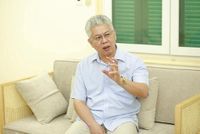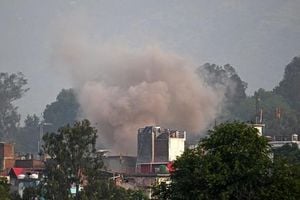In the face of global economic uncertainties, Vietnam's growth prospects remain bright, according to major international financial institutions. The World Bank (WB) has forecasted a growth rate of 5.8% for the country in 2025, while the Asian Development Bank (ADB) is even more optimistic, projecting a 6.6% growth. These figures not only surpass many countries in the East Asia-Pacific region but also reflect Vietnam's ongoing efforts to stabilize its macroeconomic environment, reform policies, and enhance economic integration.
The current growth momentum is driven primarily by a robust recovery in exports, which surged by 15.5% in 2024. This export growth, coupled with a revitalized real estate market supported by low-interest rates and increased supply, has significantly improved the labor market. Real incomes rose by nearly 5% in 2024, contributing to a noticeable decline in poverty levels, with the poverty rate expected to drop to just 3.6% by 2025, according to international standards.
However, challenges remain. The high savings rate among the population, currently at 37.2%, indicates that domestic consumption has not fully rebounded. Additionally, external risks, including geopolitical instability and trade conflicts, pose potential threats to economic recovery. Both the WB and ADB have raised concerns about Vietnam's reliance on global supply chains, especially as growth in the United States and China, its two largest trading partners, shows signs of slowing.
In light of these challenges, the ADB emphasizes the necessity for Vietnam to accelerate institutional reforms and effectively leverage free trade agreements (FTAs) to enhance national resilience and competitiveness. Despite the cautious approach of foreign direct investment (FDI) investors amid uncertainties, they tend to plan for the long term. Thus, improving the investment environment remains crucial for retaining and attracting quality capital.
On the trade front, Vietnam is proactively pursuing negotiations with the United States to address tariff issues. On April 23, 2025, Vietnam's Minister of Industry and Trade, Nguyen Hong Dien, and USTR Jamieson L. Greer engaged in a productive phone conversation regarding bilateral economic and trade matters. This dialogue follows a previous call between President Donald Trump and General Secretary To Lam on April 4, 2025. Both parties acknowledged the importance of achieving swift progress toward reciprocal and balanced trade between the U.S. and Vietnam.
Vietnam has shown goodwill by increasing imports from the U.S., and although no final decisions have been made, the negotiations indicate a willingness from both sides to discuss pressing issues. The outcome will depend on whether the two countries can find a way to protect each other's interests while maintaining a strong trade relationship.
Beyond immediate economic reforms, Vietnam is also setting its sights on long-term ambitions, particularly the establishment of an international financial center in Ho Chi Minh City. This initiative aims to elevate the country's status on the global financial map. With a rapidly developing digital economy, a strategic location in Southeast Asia, and deep integration through various FTAs, Vietnam is creating an attractive foundation for international investors.
However, experts caution that to realize this ambition, Vietnam must address fundamental issues such as barriers to capital flow, the need for high-quality human resources, foreign ownership rights, and currency conversion. Significant upgrades to both physical and digital infrastructure are also necessary. Support programs from foreign partners could pave the way for achieving these goals.
Meanwhile, Petrovietnam, Vietnam's national oil and gas group, has played a pivotal role in the country's economic landscape since its establishment 50 years ago. According to TS Nguyen Duc Kien, Petrovietnam has made substantial contributions to the national economy, having developed the oil and gas industry from scratch and becoming a critical economic pillar. At times, Petrovietnam has contributed up to one-fourth of the national budget, helping Vietnam navigate through embargoes and transitioning from a planned to a market-oriented economy.
Petrovietnam also plays a key role in safeguarding national sovereignty and security at sea, particularly in energy development, including the shift towards gas-fired power generation. The company has pioneered the production of chemical products derived from oil, such as fertilizers, and has established a closed production process encompassing exploration, exploitation, transportation, processing, and consumption.
In recent years, Petrovietnam has excelled in mastering infrastructure technologies, particularly in oil and gas exploration and exploitation. The group has significantly contributed to the discovery and extraction of major offshore oil and gas fields, positioning Vietnam as a leading oil and gas producer in the region.
Currently, Petrovietnam accounts for about 70% of domestic gasoline production from the Dung Quat and Nghi Son refineries and approximately 13% of total electricity production in the country. The company is also focused on renewable energy projects, demonstrating its commitment to sustainable energy development.
However, Petrovietnam faces challenges, including fluctuations in global oil markets, which can impact the viability of extraction projects. The global shift towards renewable energy presents another hurdle, requiring Petrovietnam to adapt and invest in new energy sources. Additionally, the search for new oil fields is becoming increasingly difficult as traditional sources are nearing depletion, necessitating significant investment and advanced technology to explore offshore areas.
Financial stability and risk management are critical issues as well, especially amid global economic uncertainties. The company must navigate inflation, exchange rates, and political conditions that could affect its operations. Furthermore, regulatory changes from the government regarding the energy sector could pose compliance challenges for Petrovietnam, particularly concerning environmental protection and sustainable practices.
Despite these challenges, Petrovietnam remains committed to sustainable development and technological innovation. The group aims to lead Vietnam's energy transition, particularly in renewable energy sectors such as offshore wind and hydrogen production. To achieve this, the government must establish a clear regulatory framework and provide necessary support for renewable energy projects.
As Vietnam continues to navigate its economic landscape, the contributions of both the government and key industries like Petrovietnam will be crucial in shaping a sustainable and resilient future.




